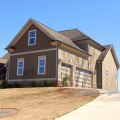For the first time since the recession, housing sizes are shrinking. The average area of the single-family square floor fell 73 feet from the first to the second quarter of this year, according to the National Association of Home Builders (NAHB) and the U. S. UU.
This is a clear reversal in the tendency of builders to focus on high-end buyers, resulting in an ossified housing policy that strengthens existing housing and denies new types of housing that may be better suited to smaller homes and a more stagnant economic environment. The trend of small houses has grown exponentially, as technology allows people to equip small spaces with great comforts. While house prices have skyrocketed in recent years, on the other hand, the average home size has started to decline. Housing expectations have changed so much over the past fifty years that it's hard to imagine a return to what past households would have considered normal middle class housing.
Today, an average new home is more than 1,000 square feet than a house from the 1960s, often housing only a couple and their dog. But that doesn't mean that people in the middle can only afford a shack in a slum, as long as governments allow more basic housing to be built. Over the past few decades, local governments have continued to increase mandates about how many units can be built per acre and what size those new homes can be. In some cities, it's not just the price of housing that's rising, but so is space, as larger properties offer homebuyers more opportunities to start families and expand.
In addition, community groups that oppose anything that sounds like density or zoning will use the power of local governments to crush developers' attempts to build more affordable housing. But where have house prices risen the most? Is there any place left where you can find good value for money? Either governments persist indefinitely with restrictions on undesirable housing, meaning that housing costs are skyrocketing, or local governments are finally starting to allow builders to build housing better suited to the needs of the middle class The devastating hurricanes that hit the part the southeast of the country last month could aggravate existing challenges, at a time of housing shortages. Developers have long mentioned the shortage of workers and land as part of the reason why, regardless of size, there is a shortage of affordable housing. Many neighborhoods are in the midst of this type of transformation, with older, denser homes being transformed into larger single-family homes. The shrinking size of houses is an undeniable reality in today's market. With house prices skyrocketing and land becoming increasingly scarce, it's no surprise that builders are focusing on smaller homes. Technology has allowed people to equip small spaces with great comforts, making them more attractive for buyers looking for value for money.
Local governments have also increased mandates about how many units can be built per acre and what size those new homes can be. This has resulted in an ossified housing policy designed to strengthen existing housing and deny new types of housing that may be better suited to smaller homes and a more stagnant economic environment. The recent hurricanes that hit parts of the southeast United States have further exacerbated existing challenges in terms of affordable housing shortages. Developers have long mentioned the shortage of workers and land as part of the reason why there is a shortage of affordable housing regardless of size. As such, it is essential for local governments to allow builders to build more suitable housing for middle-class buyers.



